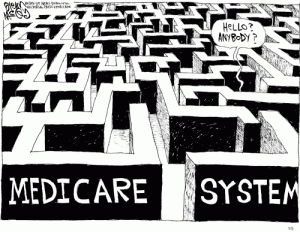This is part 2 of a series on the Senior Housing Financial gap. You can find part 1 HERE
Last week I talked about the huge gap in senior housing for Boomers who are not able to afford typical independent living/assisted living monthly fees. Over the next decades this gap will grow, creating pressure on the health care delivery system, senior housing companies and families. That being said, because this gap exists I also believe it presents some tremendous opportunities for nimble creative operators and developers.
I am hoping this blog posting will serve as the beginning of a conversation on what these opportunities might look like. Here are some of my thoughts .
1. More Modest Communities – I love going on vacation to nice places and staying in nice hotels. That being said, I am not sure I would be happy living the rest of my life in a luxury hotel. I would miss home cooked meals and taking care of myself. In fact, on a recent business trip I ended up staying in the Four Seasons Hotel in Las Vegas and honestly it was so much luxury that it felt intrusive.
The starting place for creating more modest communities is to substantially reduce the size of common areas, most of the common areas in a community look nice but are rarely used. Shaving the size of living units will also reduce costs. Big saving can also be achieved by using more of a cookie cutter approach to designing projects. Rather than starting from scratch on each new project, developing a pro forma project design that focuses on economy rather than luxury, then modifying that plan to accommodate the local concerns would result in greater efficiencies.
2. Mixed Age Communities – I have to credit one of the blog readers for this idea, but I like it a lot. We have created this idea that seniors are from another planet and should be segregated from the rest of us except for visits by friends and families. It makes a lot of sense that a mixed population would spread costs and make these communities more attractive.
3. Working Communities – The thing I find most concerning about the whole concept of luxury senior housing is that the very concept, sends the message that seniors have no further value to society. That their only function is to consume resources until they die. Sure the consuming is done in a very comfortable setting but none the less they are told they have nothing further to contribute.
How about hiring the seniors to work in the community as a way to reduce costs and create meaning in their lives? There are so many places they could serve doing tours of the community, at the reception desk, data entry, managing web pages, helping in the kitchen.
Several months ago I read about someone, who is developing smaller assisted living buildings (around 30 residents) where the residents and staff are integrated to look more like a family rather than a hotel. This means that a resident might prepare one or more meals (with help from other residents and staff); Another might play the piano or sing for the activities program.
I would love to hear year ideas about how to turn this gap into opportunity.
Don’t miss a single issue of Senior Housing Forum, subscribe today. It is free! We do not sell or share your contact information. The posts are practical and never too long.
Go to the main page of Senior Housing Forum and on the right hand side you will see a place to enter your email to subscribe. You will receive notification when a new article is posted. You can unsubscribe at any time.









I totally agree that something will have to be done about the boomers financial plight when it comes to existing housing expense. I believe we are witnessing and caring for the last generation that are able to afford the costs involved in Senior Living. We as an industry will have to re-think the business as usual concept with the existing models available. Families are hard pressed to make the monthly costs now. A change is definetly in the wind. I feel that corporate coffers on the grand scale that we have witnessed will soon be a thing of the past as we “the global family” stretch what we have left to cover costs in the future!
Thanks Beth, I think already while profitable, senior housing is not for the most part a goldmine with easy pickings. Everyone is having to fight hard to get residents, provide the right services and manage costs. You say “I believe we are witnessing and caring for the last generation that will be able to afford the costs involved . .” I largely agree. There will always be a slice of the pie who can afford hotel style care, but as a percentage of the generation it will continue to shrink.
There is one unknown factor which is inheritance. I think we will find there are a fair number of the boomer generation who will inherit enough money to allow them to continue to live above what their own resources would otherwise provide.
Steve Moran
I agree with earlier comments regarding smaller more modest communities with limited niceties as well as making them multi-generational. Additionally, for self pay clients with limited intake paperwork perhaps extending the community to extended stay clients in the area. As a business traveler who has stayed as long as 9 months in extended living – I can say I much prefer the option of staying at a modestly priced community – where I can in fact experience a sense of community such as game nights, book club…etc. Recently I read the story of a woman who had lived at a modestly priced extended stay hotel in the VA – DC area for 17 years. It was cheaper than most apartment rents and adequate for her needs. This planted the seed in my mind.
Lisa that is a cool idea. I know that when I was in management I would often stay in a guest unit at the community where I was working and it was always a great experience. It makes sense that corporations could create arangements with these communities to provide housing at a cost that would be lower than hotels.
From LinkedIn Groups
I like your ideas, Steve. They all make good sense. As a small to medium sized RCFE (12 private bedrooms in Vista, CA), we are doing exactly the things you are suggesting, and are able to provide excellent care for a fixed rate of $3,500.00 including incontinence care. However, we still have only a 75% occupancy rate. As I wrote in my recent blog on http://www.evergreenchalet.com/2011/10/long-term-care-costs-rise/ we cannot understand why we are not full. I am sure you are right about the financial problems of Boomers, but somehow those who do make the move, prefer the more lavish and costlier facilities. Perhaps the huge gap you are talking about is indeed a decade or more down the road. The problem is I cannot wait that long. I am in business for 11 years and if things don’t improve I might go under soon. I barely break even. If this is the case with other medium sized operators, I don’t see why an investor would spend his dollars on developing new facilities.
Posted by George
From LinkedIn Groups
Steve Moran • George I really resonate with your comments. Several weeks ago I wrote an article where I challenged the value of referral agencies http://wp.me/p1NmYk-2F. Your small community where residents can get great care for a modest cost would seem to be an ideal fit for these referral agencies, If they were willing to really work in the best interests of their clients I suspect you would be full.
Your blog comments are well directed. The current model will not survive into the years where boomers require advanced assistance. In supplementing your observations and predictions, I would add a possible future community where older adults reside in connected, modest housing units that share common leisure activity spaces, gardens, fitness spaces, etc. where many activities are performed to support the whole group. Remember how much fun it was living in a dormitoryapartment at college where your friends were there to help out, and to have fun? It is a lifestyle where we feel comfortable – the current generation served does not. Most boomers will not be capable of affording the senior housing and services models we have established; at least not for very long. And, we are and will remain in denial of being or becoming “old.” New paradigms are soon to arrive in all matters related to ‘old age’. Emerging technologies in health monitoring will aid in keeping folks independent of assistance for longer periods of time. A cooperative living model will not only be economically necessary, it may be desirable in fulfilling our social needs along with everything else. Folks will want things to do, to contribute, places to go, to be stimulated in mind and body, etc. and then retire for the day to a modest residence of comfort – bed, bath, kitchen, family room…a simple, but comfortable and nurturing environ, free from any obvious clinical references.
Mark that is a great concept.
Steve Moran
Steve Moran • John, that is a very potsiive way of looking at it though next week’s article will include some crystal ball gazing on my part.
Steve, I agree with you. There are many things for us to be concerned about in this industry. We need to fight regulation that will drive costs up. A focus on health and wellness for our residents is important. In my facilities we have rates that range from $2200 to $3500 per month. Our facilities range in size from 40- 60 beds. We experience greater than average occupancy in our markets. I think the focus for the foreseeable future needs to be on smaller more efficient facilities. We also need to plug into volunteerism from the local communities ( particularly Churches) to help us keep costs down and add to the quality of life of our residents. There are both risks and opportunities ahead.
Bruce those are great ideas. I would be intrested in hearing more about your communities. I am intrigued that you are able to provide services at those modest rates.
Steve Moran
Great discussion and really encouraging to hear a new perspective on the scale and character of new housing for seniors from the US, we had you guys down as only wanting to do the big stuff! From the UK angle, we have to be able to deliver at small scale as the market is predominantly local and we have so many rural / small town situations to respond to. At the same time, we are also facing a history of under occupancy in premium priced senior projects which we need to understand and deal with before we can plan the next tranche of provision, (and importantly provide the funders with justification for new developments). There is no doubt that the community / co-operative living models offer a much more human and intimate way of life, the Dutch have a really useful experience of providing housing & care for later life in small households – 5 or 6 bedroomed, with live in carer(s), shared kitchens and living areas – either in dense urban forms such as 4-5 storey apartment buildings or as part of multi dwelling developments of up to 150 units. The Dutch have used this non-institutional domestic model for end of life and mid level dementia, something we are studying further and hoping to introduce on a wider scale in the UK. Other than that, we are looking towards urban forms of provision in the 30 – 50 apartment range, aimed very much at older people of ‘average means’ rather than the wealthy. That is the largest group in our society and where there is the greatest shortfall in provision. In our case the immature nature of our market means there is still a lot to be done in establishing recognisable and understandable terminology amongst the public for the various ‘flavours’ of housing and care provision, there is a tendency to overcomplicate the language & offer with little commonality between providers & often a rather simplistic view of the potential size of the market, which comes back to just how many of the boomer generation can you realistically expect to appeal to with any one product. Too many UK operators fail to analyse the market sufficiently, I aim to change that!
From LinkedIn Groups
Keep in mind that it isn’t just the rent that creates the affordability barrier for seniors, its also the utilities, access to transportation, access to affordable shopping for necessities, and access to community services.
Just speaking from my experience, we get a lot of calls from senior housing residents that would like Internet or cable TV service, but can’t afford to pay the cable company a retail option. The Internet could provide them the access to the community programs and connections that could solve some of their other problems.
The question I would pose is how do you make senior living more affordable overall?
Posted by Carl
A nice set of articles and many helpful comments. My comment is from observations as a regular visitor over a few years to my parents at a couple different Continuing Care Retirement Communities and now my Mom is a Skilled Nursing Facility. It seems to me that addressing some of the perceived inadequacies of the current system might improve a gloomy future outlook.
I think various senior facilities probably mis-judged the bubble and paid too much when they began some of the aggressive construction that probably meant expense outlays and leveraging of debt to pay real-estate and construction companies. In order to invest for the future, they underplayed sufficiently accomodating seniors to function as fully as possible, which was subordinated by over-emphasizing cruise-liner luxury in sales marketing. (If managers had had tougher negotiations with the builders, still charged clients the same inflated prices, but then at least put the profits towards piecemeal progress on upgrades that truly met clients needs, their marketing image would not look quite so bad. ) They passed on untold exorbitant costs as costs for the suspect level of facilities and services provided, UP-FRONT (monthly-basis), while the CLIENT’s ROI is minimal early on, yet provided sharp drops in adequacy relative to the adverse circumstances one experienced later on, as one is promoted up the tier of levels of “care”. It was very evident if you are related to the affected senior that their needs are not being met, but your efforts to draw management attention did not have much “influence” on the situation. Greater than the concerns about adequacy of the facilities, management could not adequately supervise the quality of it’s workers, their show of empathy, willingness to perform duties, creativity, and capability.
My mother’s Skilled Nursing Facility charges more than than CCRC did for her Assisted Living. She has no control of the other assigned to her, or the way in which her roommates’ incontinence issues are handled. Please at least a separate room for every senior! There is a corresponding obligation to the workers for equipment that helps them to deal with the most unpleasant tasks. (These do not seem to be addressed in a hospital settings either, but you could argue that the hospital is not a permanant residence). Regulation of heating and air conditioning/ventilation is also unhealthy and inadequate. For these reasons alone, it is a wonder to me that regulators have not come down on this organization. The social program for most clients is minimal, and appears to amount to wheeling them out of their rooms and seating them together near the desk for the wing station. Incidentally this facility was described to us as one of the top residences in the provider’s system! There are also some bright, hard-working, and kind-hearted people working at this institution to address these issues.
I liked the above comments describing a cooperative living model and the mention of small household of 5 or 6 bedrooms with live-in care-givers, shared kitchens and living areas. I wonder if it could help to have government help struggling home-owners and banks with a large inventory of defaulted homes, by providing incentives to help skilled nursing facilities meet milestones to have all of its residents minimally in their own bedrooms by a certain date. Wise retrofitting, might give a degree of business to senior facilities building and maintenance companies. I also think that fair wage and benefit offerings for the large market of currently unemployed workers could be organized to provide many individualized needs for many seniors.
As a 67 year old RN, M.Ed., LNHA still working as an educator, I would like to offer what my peers and I think.
Obviously – a sustainable life style is # 1. To that end, I have researched all manner of innovative options. Co-housing, Green Homes (Tupelo), Intentional Communities, Aging in Place, Resident Centered Care, Medical Home, award winning RV communities that provide home health / assisted living.
Minimally at the independent living level – I would like 1 floor with a walkout basement-400-1500 sq ft. Duplex or quad with a common area link is ideal. Walkable community. Major resources (hospital, library, church, shopping and a college) near. Communities designed with Smart Code are excellent. Handyman services essential. I do not want to vet handymen.
Early care needs are met in kind with residents taking turns. This worked for my mother until she passed. She never had to resort to home health or a nursing home.
Moderate care needs = home health. Residential care needs: a center that is engaged with the community in which it is placed. My favorites are those that are run by the residents to a notable degree. Many of us are talking about doing this very thing – for ourselves – with kindred spirits.
Minimally in life (unless I’m in a vegetative state or very acutely ill)- I want a small private space with my own bath and a small table/ workspace/ computer or sewing machine space with a mini kitchenette (under counter refrig., microwave and cabinet. (See Tiny Homes – 87 to 400 sq feet).
My grandparents lived a very simple life off the land until they became acutely ill in their 90’s. It was a nice life and fairly easy to do. Community is key.
Sustainability comes from church and community. We must learn to maximize resources already in place. Segregation of age groups makes no sense.
Many colleges today are receiving large grants to prepare career pathways. There are many avenues of tag teaming with other entities to make the best use of our times and monies. What are your townships and cities doing? Are they on the bandwagon? Your churches? Your schools and colleges? We need only to connect the dots. Everything is there. My age group wants to be around interesting people who are engaged in living in the best way they can be. To wit: One bedridden resident happily playing a harmonica while his roomie with dementia – sang. When people are free to interact and do a skill of interest, all is well. No cookie-cutter lifestyle for me and ditto say my cohorts and peers. We just want to be people – not wards. Person hood is the only value to consider in any decision. What best supports the person. When acutely ill – minimal intrusiveness, clean space, good bed, chair, table, bath, music of choice, light fare of choice, privacy, light / dark as needed, no noise and no smells.
Residents are able to create their own sustainable lifestyle if the community supports are in place. Cookie cutter communities assume chair and bed is all that is needed.
Very good insight. I have been disillusioned by the current model of nursing home care. The Eden Alternative makes an attempt to change the institutional model, yet it is hard to change the mind-set of the staff. In the current model, nurses are often overwhelmed with work as it is (the C.N.A.’s also). In addition, the directors, such as the Activity Director, is told by management that he/she must abide by a certain amount of alloted hours to follow the budget. One example is a place who was having the staff go through the Eden Alternative training yet staffed the C.N.A. during the evening shift 2 c.n.a.’s to 30 some residents where many of the residents needed heavy care.
I have worked in nursing homes that are attempting to create the Eden Alternative yet they keep the hours of the staff so low there is not any way it can be done!
I think this multi-generational model would be good. We could find good people who became unemployed, give them discount on rent, who could work within the community, planting gardens with the residents, etc. We could find single young mothers struggling to survive who could live and work in the community while raising their children with the added benefit of have adopted grand-parents to help the young children These young mothers could do jobs depending on their skills, for example one could be helping with the gardening, another with cleaning, another a C.n.A., etc.
Of course we would do back ground checks on anyone who wished to join the community.
This community could also work with the local farmers to procure the food needed, could even start their own little grocery store. This could be a non-profit where fund raising activities be conducted not only for their little community but for the area they live in.
As a nursing home administrator, I attempted to have almost a monthly fund raising activity within the community when I was down in Missouri.
I agree with the concept but I don’t know why it has to be multi-generational. I think we are way to quick to put our seniors out to pasture. They may need some assistance in an aspect or two of their lives but that does not mean there is not something left that they can contribute.
I think one of the biggest issues and most costly will be the number of memory care residents that will be needing care in the near future. The cost for a resident in memory care is high because of the continual supervision needed. Plus every resident displays symptoms and reacts differently so there is no one size fits all solution available.
I think if we could team up a assisted living resident who was cognitivly still sharp with a memory care resident we could create a win-win situation. That assisted living resident would have a job, and thus have a sense of purpose which is so vital. They could be given a small salary or stipend for their service thus helping their economic situation.
If they had the same memory care resident all the time the memory care resident would be getting a lot of one on one time with someone who really begins to understand them. Plus with having a caregiver much nearer to their age bracket that care giver will remember back to a time where the memory care resident is, since often long term memory remains and short term goes first. You would need a coordinater to supervise and some training but overall I see it as bringing down the cost of care in memory care and offering some assistance to asssisted living residents who have needs.
Plus it would be a boost for both residents. I don’t know no one is trying this….to simple I guess. But seems like a good plan to me.